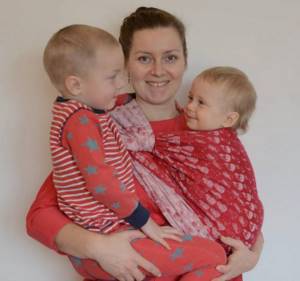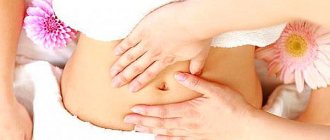Hello, dear readers! In this article we will talk about how to wear a bandage after childbirth . Many mothers are puzzled by the issues of choosing a postpartum bandage and how to wear it correctly. They are doing the right thing by asking such questions. An incorrectly selected and worn bandage can have an extremely negative impact on a woman’s health in the future.
Let's look at why the bandage was originally created, how it affects the postpartum recovery process, the pelvic floor and abdominal muscles. And also how to wear a bandage for health benefits.
How to wear a corset correctly?
Despite the fact that a weight loss bandage has significant advantages, do not forget that it must be used correctly.
Otherwise, it will not only not be able to help, but will also cause harm to health. In order not to harm the body, you need to understand how to properly put on the corrective product. The stretcher should be worn while lying down. Being in a horizontal position on your back, so that the internal organs automatically take the desired position. Thus, we exclude the possibility of their injury. Also, do not forget that each tightening product has a certain time of use. It is strictly forbidden to wear corrective products throughout the day. This is due to the fact that not only the abdominal muscles are toned, but also the internal organs. If this is a big plus for the abdomen, then for the abdominal organs it is a minus. For this reason, when purchasing a body contouring product, it is worth checking the time of its use.
When do abdominal muscles lose tone?
Most often this occurs after pregnancy . At this time, the anterior abdominal wall and muscles stretch and “get used” to the decrease in tone. Since it is difficult for the muscles to tone up immediately, this condition persists even after the birth of the child. If you do not tighten your stomach in time, the anterior abdominal wall may remain convex forever.
The second most common cause of loss of abdominal tone is surgery on the anterior abdominal wall. After surgery, the cut and surgically repaired muscles inevitably weaken and the abdomen becomes stretched. In order to avoid stretching of the abdominal muscles and “protrusion” of the anterior abdominal wall after childbirth and surgery, it is recommended to wear the Intex abdominal bandage for 2-3 weeks. In addition, tightening your waist with an elastic bandage .
Compression elastic bandage for the waist "Intex" is a woven tensile tape made of latex, cotton and polyester fiber. Elastic abdominal bandage : - Prevents the anterior abdominal wall from “sagging” and relieves the abdominal muscles immediately after surgery; — Stimulates blood flow to the abdominal area. This improves muscle nutrition and allows you to restore their tone as soon as possible; — Corrects the figure and creates a beautiful cosmetic effect.
How to get rid of diastasis?
No amount of crunching will help get rid of muscle separation, since this exercise does not involve the internal abdominal muscles. Diastasis is the main reason why the belly protrudes. To help get rid of diastasis, the following physical exercises have been created:
- “Vacuum” is considered the most effective exercise for contracting the internal abdominal muscles. Due to this, a muscle corset is formed, it will hold the internal organs and will not allow them to put pressure on the front wall of the abdomen. If you regularly perform this exercise, then after the first month you can see a positive result.
- “Plank” is a static exercise that uses the internal abdominal muscles. There are different types of planks that you can alternate during your workout.
Be sure to use this set of exercises to quickly get a flat stomach.
When to do this?
Young mothers are often interested in: when to start tightening their belly so as not to cause complications and achieve noticeable results? It is impossible to answer this question unambiguously, because everything depends on the woman’s physique, on how the birth went, on the course of the postpartum period and individual characteristics.
After the birth of a child, the body undergoes a considerable number of changes. The uterus actively contracts, freeing itself from unnecessary muscle cells. The mucous membrane of the reproductive organ is renewed. In this case, the woman is bothered by pain and bleeding. Having become smaller, the uterus takes an anatomically correct position in the pelvic cavity
In order not to interfere with such an important process, external pressure should not be applied immediately, within 3-5 days after birth
If there is a need to wear a bandage on the first day after delivery, it should not be tightened. The device should not be worn too tightly, so that the muscles are supported and the blood flow is not disturbed.
After a cesarean section or natural childbirth, during which ruptures or incisions of the perineum appeared, sutures are required. If healing is problematic, tying in the postpartum period is not done too tightly so as not to provoke the development of complications. Doctors assure that in such cases it is better to wait time and tie up the stomach 14-20 days after birth.
Methods for tying up the belly
To support muscles weakened during pregnancy, mothers who have recently given birth use special devices: a tightening corset or belt, figure-shaping underwear, a bandage, etc. Factory-made products can be purchased at any pharmacy and, after consulting with a specialist, begin restorative and corrective measures . If there is no tightening device at hand, women resort to the help of improvised means.
For tying up the abdomen during the postpartum period, a diaper, a baby sheet, or a piece of cloth are suitable. To achieve maximum effect, the following recommendations must be followed:
- you need to lie on your back;
- fold the diaper in the form of a scarf (diagonally);
- cover the area of the abdomen between the pubis and the navel;
- wrap the ends of the scarf around your hips and bring them forward;
- make a knot opposite the protruding pelvic bones;
- under the diaper, push the stretched fabric from the pubis to a level above the knot;
- get out of bed sideways.
For plump women, it is better to use a sheet instead of a diaper. Pull according to the above plan, except that you need to turn around 2-3 times
It is very important to distribute the sheet evenly over the body and only then tie it up. After a caesarean section, this method of tightening is not suitable, since the material gathers in folds and puts pressure on the seams
It is better to purchase a comfortable product made from natural fibers that allow the skin to breathe freely. In order for the tightening to bring maximum effect, you need to choose a bandage of your size.
You should not wear a bandage one size smaller, trying to tighten your stomach as much as possible. This can lead to poor circulation. It makes no sense to use used bandages. Such products are stretched and therefore ineffective.
Almost all types of bandages, except corsets, are worn while lying down
When choosing shapewear, you should pay special attention to the rigidity of the waistband. It shouldn't put pressure on your stomach
Using a sling (a thick scarf) it is quite easy to tighten your belly after childbirth. Afterwards, some mothers use a device to carry the baby. Winding rules:
- lie on your back, put a scarf on your waist;
- cross the ends behind your back, bring them forward;
- wrap another layer, closer to the pubis;
- pull up sagging fabrics, tie the ends into a knot on the side.
The first layer acts as a frame that holds the stretched skin, the second one supports the muscles. When a woman stands up, the stretched skin hangs over the bottom layer of the sling. This is normal, because pulling too tightly will cause discomfort.
The main convenience of this device is that it can be wrapped over linen or home clothes. Many mothers note the advantage of a sling over bandages. A dense scarf supports the muscles, accelerating the restoration of their elasticity, unlike bandages that press the tissue inward.
Postpartum tying: personal experience of a specialist
Remembering my first experience of a long and painful postpartum recovery, I previously studied all the sources available to me about postpartum tying, including English ones, and took a short sling to the maternity hospital. I had to use it just a couple of hours after giving birth, when I needed to move from the delivery room to the ward. Even then, the sensations from a couple of steps without tying up and with a tying up belly were radically different; there was a feeling of soft support for both the tummy, the pelvic bones and the sore lower back.
Read also: Prenatal abdominal tying: personal experience of a specialist
In order to understand how tying works, let’s remember what happens during pregnancy, during childbirth and after it. Under the influence of the hormone relaxin in the last stages of pregnancy and during childbirth, ligaments relax, a slight divergence of the joints of the pelvic bones is possible, the tone of the pelvic floor muscles decreases, intra-abdominal pressure changes, and organs are displaced.
Because of this, a woman after childbirth may feel pain in the lower back, nagging and aching pain in the pelvic bones and in the symphysis area. And postpartum recovery and the return of the female body to its normal state is not a quick process, it can take the notorious 40 days, or maybe longer.
Postpartum tying with a piece of fabric helps solve many of the above problems. Unlike corset-type bandages, tying with fabric does not compress the internal organs, contributing to their prolapse, but supports them. In addition, such postpartum tying can alleviate the condition of a mother who has recently given birth with hemorrhoids, constipation, organ prolapse, a poorly contracting uterus, diastasis (separation of the rectus abdominis muscles) or act as a preventive measure for such conditions.
Postpartum tying is especially important for women after a caesarean section. For such tying it is convenient to use short slings, 2.5-3 meters long
In addition to the sling after childbirth, it is convenient to tie it with any piece of waffle, linen, or cotton fabric (width -+50 cm)
For such tying, it is convenient to use short slings, 2.5-3 meters long. In addition to the sling after childbirth, it is convenient to tie it with any piece of waffle, linen, or cotton fabric (width -+50 cm).
Postpartum tying is done lying down, the knot is also tied on the side or behind.
You need to tie it up while the woman is in an upright state - walking, carrying the baby. Postpartum tying can be perfectly combined with wearing the baby in a sling (if necessary, although I, as a sling consultant and mother, recommend sticking to “bed” rest and starting an active life and mastering the sling no earlier than the body has recovered quite well after childbirth, approximately 30-40 days).
Read also: Features and choice of babywearing jacket, babywearing cover, babywearing inserts
My personal feelings from postpartum tying are the most positive - the lower back and pelvis hurt less, the uterus contracted quite quickly (this, of course, was also greatly facilitated by breastfeeding on demand), the stomach went away faster compared to the first birth and diastasis was minimal. With my tummy tied up, I could calmly hold my baby in my arms without pain in different places or spend a little time with my older one. I tied myself every time I got out of bed for more than 5 minutes.
It is also worth noting that when tying, I did not fold the fabric of the sling in two, but wound it over the entire width of the scarf - 65 cm, so I grabbed the pelvis and could tighten the sling more precisely in a way that was comfortable for me.
Read also: Sling and stroller: a convenient tandem for modern parents
40 days after giving birth, only a small diastasis remained (after all, the second pregnancy) and, of course, the tummy did not completely disappear, but in general the recovery was much faster, I would even say twice as fast as the first time, when I knew nothing about tying.
Fifth day after birth
Eighth day after birth

Our consultant:
Alena Kovriga
tel. 0934078188
Mom's KIT set
✍











